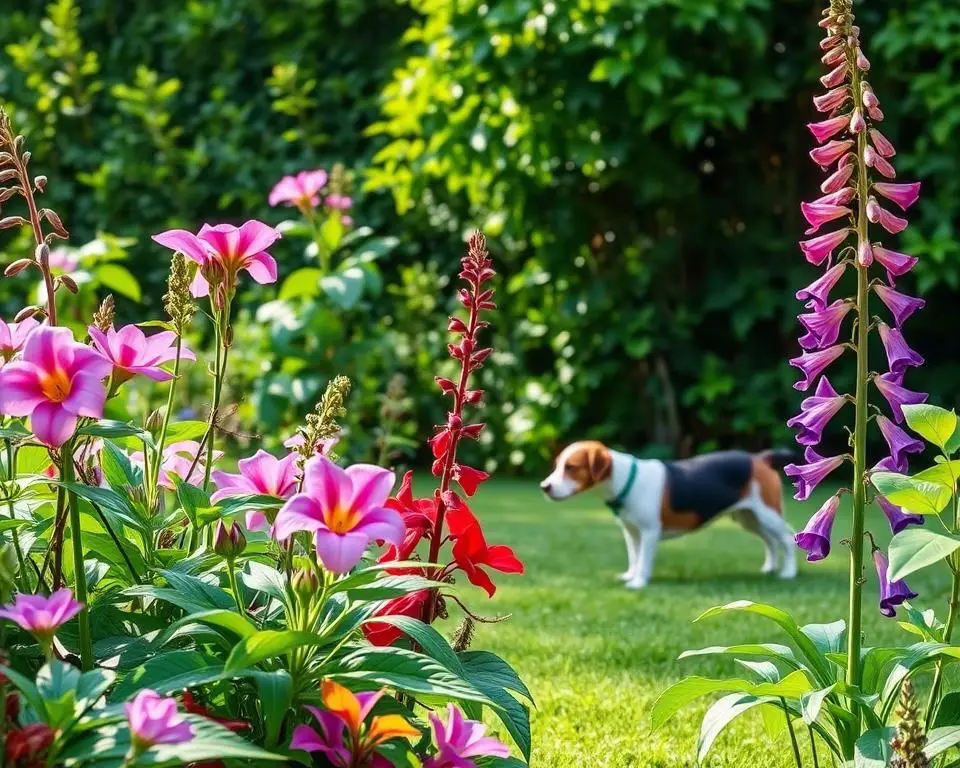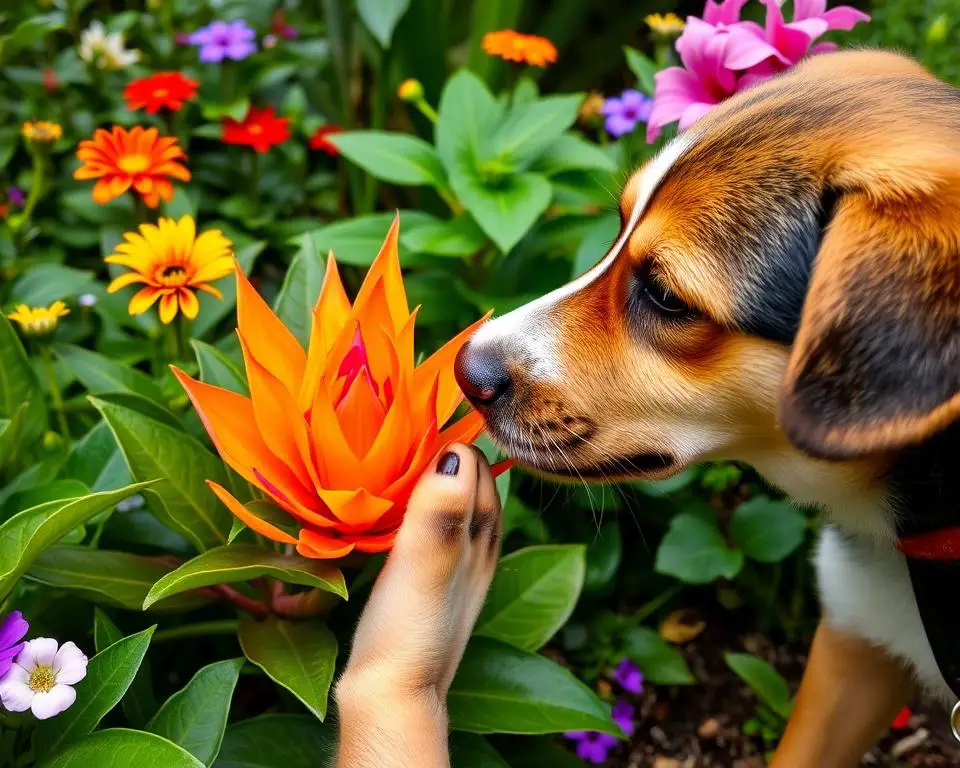As a dog owner, you want to keep your furry friend safe and healthy. But, did you know some plants in your garden or home could be dangerous to your dog? Many common plants can be toxic if dogs eat them, causing serious symptoms or even life-threatening conditions.
What plants are toxic to dogs, and how can you keep your pup safe? This guide will cover the most common poisonous plants for dogs. We’ll also talk about symptoms to watch for and steps to protect your dog. By knowing the risks and taking action, you can make a safe space for your dog and enjoy a happy life together.
Key Takeaways
- Many popular garden and household plants are highly toxic to dogs if ingested.
- Exposure to toxic plants can cause a range of symptoms, from mild gastrointestinal upset to life-threatening organ failure.
- Identifying and restricting your dog’s access to poisonous plants is crucial to keep them safe.
- Seek immediate veterinary attention if you suspect your dog has consumed a toxic plant.
- Regularly inspecting your home and yard for dangerous plants is an important part of responsible dog ownership.
Introduction: Protecting Your Dog from Poisonous Plants
As dog owners, we must watch out for dangers in our yards and homes. Many plants can be toxic to our dogs, causing serious health issues if eaten. In 2022, the ASPCA Animal Poison Control Center got nearly 9% of calls about pets eating poisonous plants.
Overview of Common Poisonous Plants and Their Dangers
Popular plants like philodendrons and dieffenbachia can be harmful to dogs. So are outdoor shrubs like azaleas and rhododendrons. These plants can make dogs very sick, causing vomiting, diarrhea, and even neurological problems. Some plants, like the autumn crocus and Japanese yew, can be deadly.
Importance of Identifying and Restricting Access to Toxic Plants
It’s important for pet owners to know which plants are toxic to dogs. Puppies and small dogs are more at risk because they like to chew on things and are smaller. Keeping your home and yard free from plants dangerous to dogs helps keep your pet safe.
By knowing the dangers of poisonous plants for dogs and taking steps to prevent it, we can keep our dogs safe. This ensures they live in a safe, toxin-free world.
“Preventing plant poisoning in dogs is crucial, as even small ingestions of certain toxic plants can have severe, sometimes fatal, consequences.”
| Plant | Toxicity | Symptoms |
|---|---|---|
| Autumn Crocus | Highly Toxic | Gastrointestinal bleeding, vomiting, kidney and liver damage |
| Daffodil | Toxic | Vomiting, diarrhea, abdominal pain, convulsions, and cardiac issues |
| Lilies | Varying Toxicity | Kidney failure (especially in cats), gastrointestinal upset |
Flowers and Bulbs Poisonous to Dogs
As pet owners, knowing which flowers and bulbs are poisonous to dogs is key. Some plants can cause serious stomach problems, harm organs, and even be life-threatening. Let’s look at some of the most dangerous plants for dogs.
Autumn Crocus
The autumn crocus, or Colchicum, blooms in the fall and has a toxin called colchicine. If a dog eats this plant, it can cause gastrointestinal bleeding, severe vomiting, kidney and liver damage, and respiratory failure. Symptoms may not show up for a few days, so get vet help right away if your dog eats this plant.
Daffodil
Daffodils, including their bulbs, have a toxin called lycorine that’s highly dangerous to dogs. Eating any part of the daffodil can lead to vomiting, diarrhea, abdominal pain, abnormal heart rate, and breathing difficulties. Quick medical help is needed if your dog meets this spring flower.
Lilies
Many lily types are extremely hazardous to dogs. Some, like the Easter lily, tiger lily, and day lily, can cause kidney failure and even death if eaten. It’s important to keep your dog away from these beautiful but dangerous plants.
It’s crucial to know and block your dog’s access to these poisonous flowers and bulbs. If you think your dog has eaten any toxic plant, call your vet right away.
Shrubs and Plants Toxic to Dogs
As dog owners, knowing which shrubs and plants are toxic to dogs is key. The Azalea and Rhododendron family, and the Sago Palm, are especially dangerous.
Azalea and Rhododendron: Extremely Dangerous
Azaleas and rhododendrons are harmful to dogs. Just a few leaves can cause serious problems. These include vomiting, diarrhea, drooling, paralysis, shock, coma, and even death.
Sago Palm: One of the Most Toxic Plants
The Sago Palm is very toxic to dogs. Its seeds can cause liver failure. If your dog eats any part of it, see a vet right away.
Keep your dog away from house plants poisonous to dogs, plants toxic to dogs, and plants dangerous to dogs. Knowing which plants are harmful helps keep your dog safe.
| Toxic Plant | Toxic Parts | Symptoms |
|---|---|---|
| Azalea and Rhododendron | Leaves, flowers, nectar | Vomiting, diarrhea, drooling, paralysis, shock, coma, death |
| Sago Palm | All parts, especially seeds | Acute liver failure |
Quick action is key to protect your dog from toxic plants. Always check with your vet if you’re worried about are aloe vera poisonous to dogs, are hibiscus poisonous to dogs, are hosta poisonous to dogs, are peace lily poisonous to dogs, or are poinsettias dangerous to dogs.

Trees Poisonous to Dogs
As pet owners, knowing which plants and trees are harmful to our dogs is key. The Japanese Yew and nut trees are especially dangerous for dogs.
Japanese Yew: A Deadly Delight
The Japanese Yew is a common evergreen tree that is toxic to dogs. It has parts that can be deadly if eaten. These include dwarf and giant trees. Symptoms of poisoning include shaking, vomiting, trouble breathing, and seizures.
The tree’s bright green leaves and red berries might look nice, but keep them away from pets.
Nut Trees: Gastrointestinal Risks
Nut trees like walnut, pecan, and macadamia trees are also harmful to dogs. Eating their nuts can cause stomach problems and blockages. Keep your dog away from fallen nuts and nut trees.
As pet owners, knowing about toxic trees is crucial. By understanding the risks of Japanese Yew and nut trees, we can keep our pets safe.
“Prompt veterinary care increases the chances of recovery for dogs who have ingested toxic plants.”
Toxic Plants for Dogs
As pet owners, knowing the risks of indoor plants is key. Two plants that are harmful to dogs are philodendrons and dieffenbachia, or “dumb cane.”
Philodendrons: Mouth and Lip Irritation
Philodendrons have crystals that can irritate a dog’s mouth. If a dog eats them, it may paw at its mouth, drool a lot, and even throw up. These crystals can also swell and inflame the mouth and lips.
Dieffenbachia (Dumb Cane): Burning Sensation and Breathing Difficulties
The dieffenbachia, or “dumb cane,” is another plant that’s bad for dogs. Eating it can make a dog’s mouth burn, cause a lot of drool, and make breathing hard. This happens because the plant’s toxins swell and irritate the airways.
Keep indoor plants poisonous to dogs, house plants toxic to dogs, and toxic plants for dogs away from dogs. If your dog eats a philodendron, dumb cane, or other poisonous plants, see a vet right away to stop serious health problems.
| Plant | Toxic Compounds | Symptoms |
|---|---|---|
| Philodendron | Insoluble calcium oxalate crystals | Mouth and lip irritation, pawing at mouth, drooling, retching |
| Dieffenbachia (Dumb Cane) | Toxic compounds | Burning sensation in mouth, drooling, breathing difficulties |
“Keeping your home and yard free of poisonous plants for dogs is an essential step in ensuring your canine’s safety and well-being.”
Identifying Poisonous Plant Ingestion
If you think your dog ate a poisonous plant, act fast. Look out for signs like vomiting, diarrhea, tiredness, and problems with the brain like getting lost or having seizures.
Even a little bit of some plants can be very bad for dogs. Autumn crocus can cause bleeding in the stomach and harm organs. Sago palm can lead to liver failure. Research shows over 50% of toxic plants can cause diarrhea, and 78% may make dogs vomit.
If you think your dog ate a bad plant, don’t wait to see if they get sick. Get them to a vet right away. Quick help is key because some toxins can be very dangerous and fast.
Common Symptoms to Watch For:
- Vomiting
- Diarrhea
- Lethargy
- Neurological signs (disorientation, seizures)
Importance of Seeking Immediate Veterinary Attention
If you think your dog ate a poisonous plant, call your vet fast. They can tell you what to do next, like making your dog vomit or giving them special treatment. Quick action is very important because some toxins can be very harmful and even deadly.

“Ingestion of even a small amount of certain plants can be extremely dangerous for dogs. It’s crucial to be vigilant and seek immediate veterinary care if you suspect your pet has eaten a poisonous plant.”
Prevention and Safety Measures
As a pet owner, keeping your dog safe means checking your yard and home for toxic plants often. Dr. Jerry Klein, the American Kennel Club’s Chief Veterinary Officer, suggests being proactive to stop your dog from getting near harmful plants.
Regularly Surveying Your Yard and Home for Toxic Plants
Look over your outdoor and indoor areas for plants that could harm your dog. Watch out for lilies, azaleas, sago palms, and Japanese yew. Checking often can help you keep dogs away from poisonous plants and prevent dogs from eating poisonous plants.
Restricting Your Dog’s Access to Poisonous Plants
After finding dangerous plants, make sure your dog can’t get to them. You might use fences or keep plants in pots out of reach. Always watch your dog when they’re outside to keep them safe.
Consulting a Landscaper for Plant Removal, if Necessary
If you have tough plants to remove, talk to a professional landscaper. They can remove toxic plants from yard for dogs safely. They can also put in plants that are safe for your dog.
Don’t wait to see if your dog gets sick before getting vet help. If you think your dog ate a poisonous plant, call your vet right away.
“The most common mistake pet owners make is to wait to see if the dog becomes ill before contacting the veterinarian,” says Dr. Jerry Klein.
Most Common Mistakes and Myths
Dogs don’t naturally know which plants are poisonous. In the wild, animals may avoid dangerous plants, but our pets don’t have this skill. Many pet owners wait to see if their dog gets sick before getting help.
If you think your dog ate a toxic plant, act fast and call your vet. Some toxins can take time to show effects, and quick action is key to save your dog. Waiting and hoping your dog will be okay can lead to serious problems or even death.
Waiting to See Symptoms
Many pet owners wait to see if their dog shows symptoms before getting help. But this is risky. Some plant toxins can have delayed effects, and prompt treatment is essential to prevent serious complications or even death. If you think your dog ate a poisonous plant, call your vet right away, even if your dog seems fine.
Believing Dogs Avoid Toxic Plants
It’s also a myth that dogs know to stay away from poisonous plants. Our dogs don’t have a natural way to tell which plants are safe or not. Dogs can’t tell which plants are toxic and which are not, so it’s up to us to keep them safe.
Knowing these myths and taking steps to protect your pet is key to their safety. By staying informed and acting fast if your dog eats a plant, you can keep them safe.
Additional Resources
Dealing with plants that are toxic to dogs can be tough. But, there are great resources out there to help keep your dog safe. The ASPCA Animal Poison Control Center is key in offering advice and support for plant poisonings.
ASPCA Animal Poison Control Center Hotline
The ASPCA Animal Poison Control Center has a 24-hour hotline at 1-888-426-4435. It’s staffed by experts in veterinary toxicology and pharmacy. This hotline is a lifesaver if your dog eats a poisonous plant. Calling them fast can really help, as quick medical care is often crucial.
List of Common Toxic and Non-Toxic Plants for Dogs
There are also lists of plants safe or dangerous for dogs from trusted sources. These lists are super helpful for pet owners. They can spot dangers at home and pick safe plants for gardens and inside. Knowing these lists helps dog owners keep their pets safe.
| Toxic Plants for Dogs | Non-Toxic Plants for Dogs |
|---|---|
|
|
Being informed and proactive lets dog owners make a safe space for their pets. This way, they can enjoy nature and plants safely.
Toxic Plants for Dogs
As pet owners, knowing which plants are harmful to our dogs is key. Many common plants at home and in gardens can be dangerous. Learning about these plants helps us keep our pets safe and healthy.
Azaleas and Rhododendrons
Azaleas and rhododendrons are very dangerous for dogs. They have toxins called grayanotoxins that can make dogs drool, lose their appetite, and feel weak. They can also cause leg paralysis and serious stomach problems.
Begonias
Begonias are toxic to dogs with over 1,000 types. If dogs eat these plants, they might vomit, have mouth irritation, and drool a lot.
Daffodils
Daffodils are dangerous if dogs eat the bulb. This can cause vomiting, shaking, and heart issues.
Fiddle Leaf Figs
Fiddle Leaf Figs are not safe for dogs. They have calcium oxalate crystals that can irritate a dog’s mouth, throat, and stomach.
Gardenias
Gardenias are toxic to dogs with saponins and alkaloids. These can cause stomach problems, vomiting, and heart issues.
Geraniums
Geraniums are bad for dogs because of geraniol and linalool. Dogs may eat less, vomit, and get skin irritation.
Honeysuckle
Honeysuckle is very dangerous for dogs with cyanogenic glycosides and carotenoids. It can make dogs vomit, have diarrhea, and have an irregular heartbeat.
Hostas
Hostas are toxic to dogs with saponins. They can cause skin irritation, weakness, vomiting, drooling, stomach pain, and diarrhea.
Hydrangeas
Hydrangeas have cyanogenic glycoside that can make dogs very sick. Symptoms include vomiting, feeling tired, and stomach problems.
Lantana
Lantana, also called Red Sage, is harmful to dogs. It can cause many symptoms because of its toxins.
There are many plants that are very dangerous for dogs. It’s important for pet owners to know about these dangers. By understanding the symptoms and taking steps to prevent it, we can keep our dogs safe and healthy.
Conclusion
Dog owners must watch out for many plants that can harm their pets. Plants like autumn crocus, daffodils, azaleas, and Rhododendrons can cause mild to severe symptoms or even death if eaten by dogs.
Pet owners need to be proactive in keeping their dogs away from these plants. They should check their surroundings often, work with landscaping experts, and get quick vet help if they think their dog ate a toxic plant. These steps are key to keeping dogs safe.
Knowing about toxic plants for dogs and taking steps to prevent it can save your pet from harm. Keeping your dog safe and healthy is the best way to avoid accidents and keep a strong bond with your pet.
FAQ
What are some common plants that are toxic to dogs?
Autumn crocus, azalea, and rhododendron are some plants that can harm dogs. So are Japanese yew, philodendrons, and dieffenbachia (dumb cane). These can cause stomach problems, breathing issues, or even death if eaten.
How can I identify if a plant is poisonous to my dog?
Check your yard and home for dangerous plants often. If you’re not sure about a plant, ask a landscaper or your vet.
What should I do if I think my dog has eaten a poisonous plant?
Get vet help right away if you think your dog ate a bad plant. Don’t wait to see if they get sick. Some toxins can act slowly, and quick action is key. Call your vet or the ASPCA Animal Poison Control Center quickly.
Can dogs instinctively avoid eating poisonous plants?
No, dogs can’t tell safe plants from dangerous ones. It’s a myth that they will avoid bad plants. So, don’t count on it.
What are some of the most common mistakes pet owners make when it comes to poisonous plants?
Many wait to see if their dog gets sick before calling a vet. Others think dogs won’t eat bad plants. Both are wrong.
Where can I find more information on plants that are toxic to dogs?
The ASPCA Animal Poison Control Center is a good place for info on poisonous plants. You can also talk to your vet or a local landscaper for help on keeping your home and yard safe.
Poisonous Plants
Animal Poison Control
ASPCA Animal Poison Control Center Lists 10 Most Common Pet Toxins







